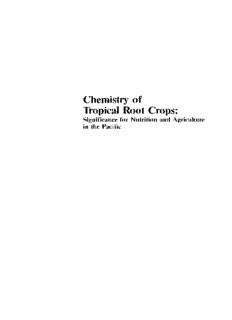
Chemistry of Tropical Root Crops PDF
Preview Chemistry of Tropical Root Crops
The World’s Largest Open Access Agricultural & Applied Economics Digital Library This document is discoverable and free to researchers across the globe due to the work of AgEcon Search. Help ensure our sustainability. Give to AgE con Search AgEcon Search http://ageconsearch.umn.edu [email protected] Papers downloaded from AgEcon Search may be used for non-commercial purposes and personal study only. No other use, including posting to another Internet site, is permitted without permission from the copyright owner (not AgEcon Search), or as allowed under the provisions of Fair Use, U.S. Copyright Act, Title 17 U.S.C. Chemistry of Tropical Root Crops: Significance for Nutrition and Agriculture in the Pacific The Australian Centre for International Agricultural Research (ACIAR) was eqah lished in June 1982 by an Act of the Australian Parliament. lis mandate is to help identify agricultural problems in developing countrics and to commission collabora tive research bctween Australian and developing country researchers in fields where Australia has a special research competence. \Vhere trade names are used thi,., does not constitute endorsement of nor discrimi nation against any product b) the Centre. I ACtAR MONOGRAPH SERIES This peer-reviewed series contains the results of original research supported hy ACIAR, or material deemed relevant to ACIAR\ re.search ohjcctives. The series is distributed internationally, with an emphasis on the Third World. Australian Centre for International Agricultural Resl'arch Ci.P.O. Box 1571, Canherra, A.e.T. 2601 Bradbur), J. H., and Hollo\\"ay, W. D. 19RR. Chemistry or Tropical Root Crop" significance for nutrition and agriculture in the Pacific. ACIAR 1\1onograph No. 0, 201 p. ISBN 0 949511 61 7 Typeset and laid out by Union Offset Co. Pty Ltd, Canherra Printed by Ramsay Ware Printing, Melhourne Chemistry of Tropical Root Crops: Significance for Nutrition and Agriculture in the Pacific J. Howard Bradbury and Warren D. Holloway Chemistry Department Australian National University, Canberra Australian Centre for International Agricultural Research Canberra 1988 Co-Workl'p; at Chl'mistr~ Ikpartml'lIf, ,\w,tralian 'lialional l'lliH'rsit~ Ro" L Ikatt", l-:a\c Ilrad'ha\\. Ilrcmloll Hammer, \\CI\ne .Icalou, . .I,,,cph 1 au, John I Cl', Tuc N!!lI"l'll, Tum l'iJilllpi,allc ~lIld \)1 L!llnid :-'ill~dl (\i,i!illL' Icllo\\ Oil ,abhalica! ka\c fnllll ICRIS,\T. H"lkrabad). ( 'ollahomtors S(J/OII/(l1I /.'/111/(/1 J)r CJrahalllc \'. H . .Iac~'()1l (L't'\J)P, /-\()-SI'C Plan! 1'I,)!,:ction Llli!, Su\a, hji) \,h,) ,\ith the pn1jl'ct lcadcl (JH.H.) dc,clop,'d the (lri!!ill~ll AC/-\R pro!!ram ill 1%-'; \Ir Petcr R. [inion, IYS3-S5 and \11 Stc\e Caigcr, 1%('-1)7, (\iini,tl\ llj ,\grielllture and Land,. 1',0. Bo\ (j 13, I-\oniara), Fiji \lr Param :-,i\C1n, 19S3-87 (Korolli\ia Rc,carch St~llilln, 1'.0. 131),77. Nau\ori). r/i'l[ern Sail/oa Dr .I III L Wil,on. 1%.1-87 (I Rl:TA. Uni\l'rsilv ul' 'South Pacilic School uf ,\gricullure. Apia). Timga ,VIr I'ita TallfalOlua and :Vir Finau S, Pule, 191\-l-87 (Departmcnt 01 Agl'iculturc, P.O, Box l-l, Nuku'alola). Kirihari :vl, Bruce Ratieta, 198-l-85 (deceased), \11' John Finlay, 1986-87 (Atoll Research and Development Unit, 1'.0. Box 206, Bikenibeu, Tar'aI,a). Papua New Guinea Dr I,. Margarct Quin, 1984-85; Or Brian M. ThisllelOIl, 191\4-87 (Department of Primary Industry, Kuk Agricultural Research Station, P.O. Box 339, Ml Hagen); I\Jr :Vlalcolm P. Lcvett, 1984·-87 (Department of Primary Industry, Aiyura, P.O. Bux 384, Kainantu, F.H. 1'.); Mr Graham A. King, 1985-87 (Dcpartment of Primary Industry, Bubia Agricultural Research Centre, P.O. Box 1639, Lac). f'cdcrated Srates of ,\,1icrollcsia (Pohll{Jei) :\lr Adclino !.orens, 1985; Mr Williarn S. v\,illiam, 1985-87 (Office of the Director of Comervation and Resource Surveillance, Pohnpei State (JO\crnmcnl). Vallll(/{U l\lr Fraser Bule, 1986-87 (Department of Agriculture, 1'.0. Box lOO, Santo). AlIstralia M r Rms B. Cunningham, 1985-87, who has advised on statist ical dcsig!! of experimcnts (Department of Statistics, Australian National Universily, Canberra). The Authors J. Howard Bradbury, PhD (Birm), DSc (Melb), DSc (ANU) is a Reader in Chemistry at the Australian National University. He has published over 160 papers on food and nutrition in develop ing countries, and on the chemistry of macromolecules and biological material. In recognition of this work he was awarded the Rennie Memorial Medal and the H. G. Smith Memorial Medal of the Royal Australian Chemical Institute and the David Syme Research Prize of the University of Melbourne. Warren D. Holloway obtained his PhD from Massey University in New Zealand. For some years he was the bio chemist in charge of the gastroentero logy laboratory at Auckland Hospital. During 1985-86 he was a postdoctoral fellow at ANU working on the ACIARI ANU program and, with Dr Bradbury, supervised the analytical work. He is now with Syrinx Research Institute, Bundaberg, Queensland. JAPAN ...M id "ay I I,:l ·R"Jnln Is I"",AWAIIAN IS IPPINE Is (TRUST TERRITORX OF THE PACIFIC ISLANDS) PACIFIC OCEAN ~A L AU : ~ Mol 0 L I NE Is ) FEJERATED STATES r;1= MICRONESIA "KIRI8A-1 :,. MARQlnSAS' FRENCH POLYNESIA VA~ JAT "I c_~ 'lJC,\ ----(J- . 50(